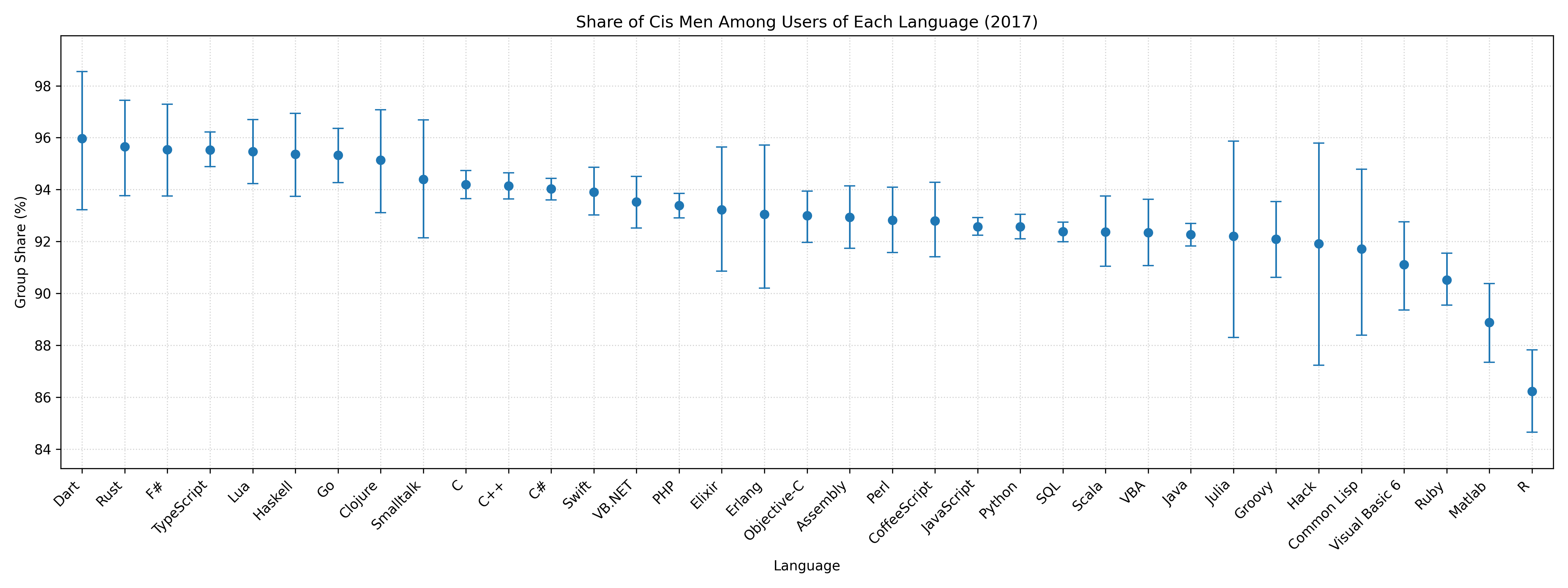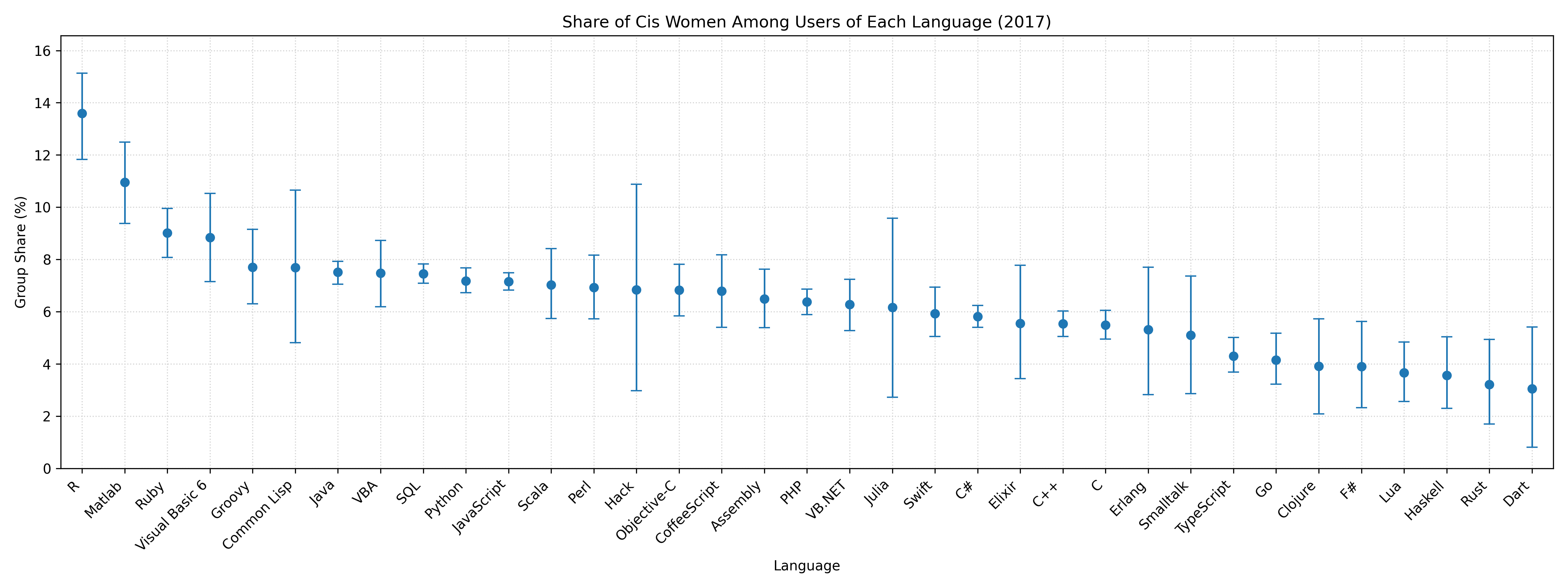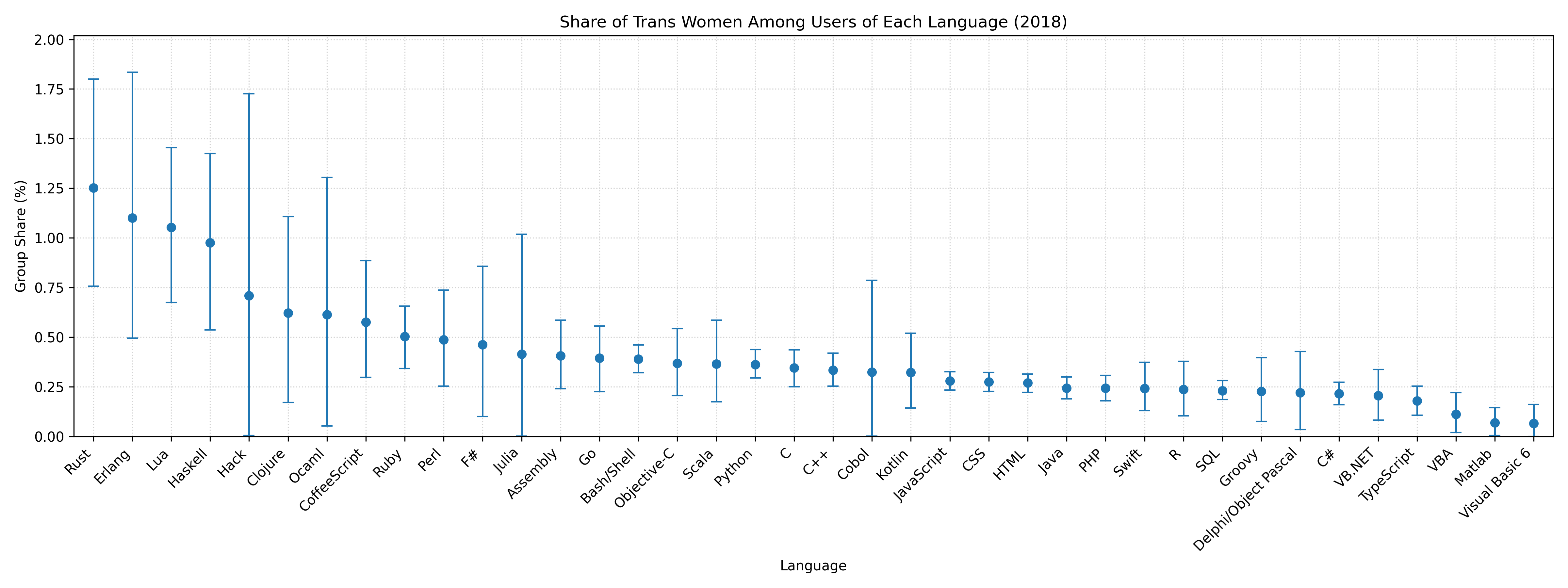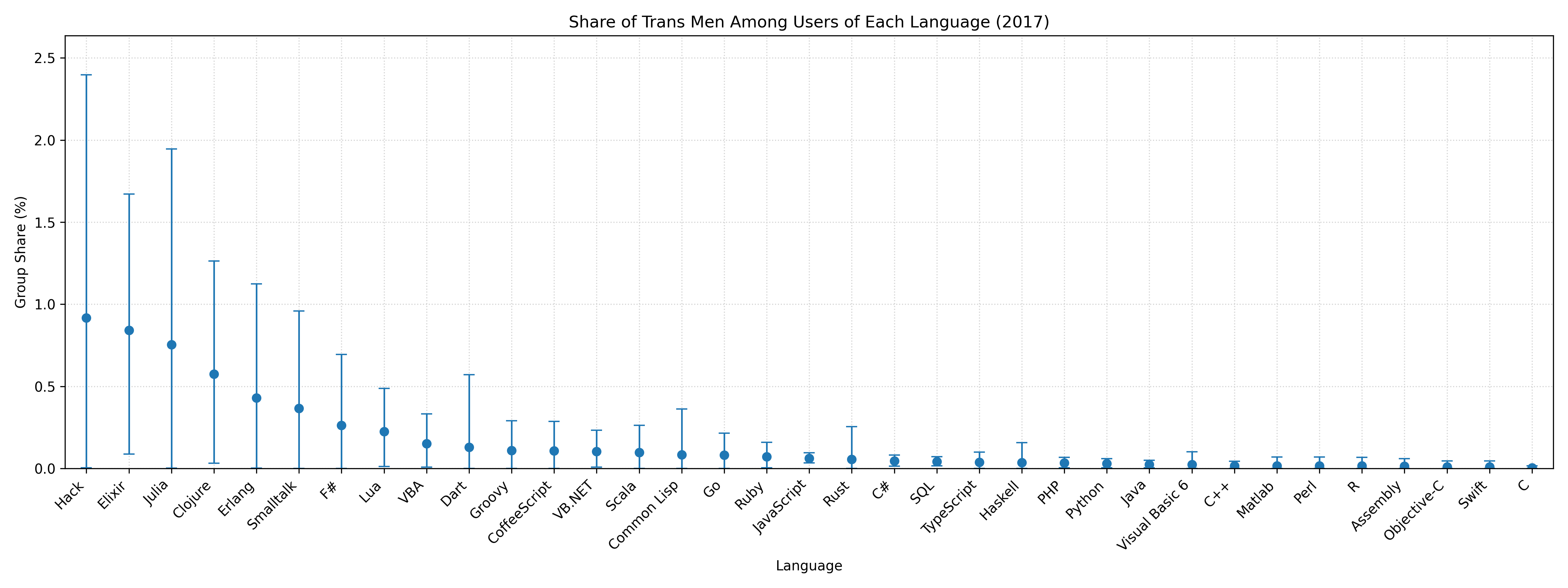Programming Language Use by Gender Identity
People often claim that Rust is unusually popular among trans women. Every year, the Stack Overflow Survey records, among other things, which languages developers use and their gender identity. This allows us to estimate how each language’s user base is distributed across gender identities. I examined the survey data to see whether it supports the perception of Rust’s popularity among trans women.
Below, I plot language use by gender and year, with 94% credible intervals. The hierarchical model smooths the proportion estimates, which is especially helpful for languages with small sample sizes.
What the Survey Shows
Cis Men
Top Languages
| 2017 | 2018 | 2019 | 2020 | 2021 | 2022 | |
| #1 | Dart (96.0%) | F# (96.1%) | Rust (95.2%) | Rust (96.4%) | Rust (96.6%) | Delphi (97.8%) |
| #2 | Rust (95.7%) | Delphi/Object Pascal (95.9%) | Go (95.1%) | Dart (95.5%) | Go (96.4%) | F# (96.5%) |
| #3 | F# (95.5%) | Groovy (95.5%) | Dart (95.0%) | Go (94.6%) | Delphi (96.4%) | Go (96.5%) |
| #4 | TypeScript (95.5%) | Lua (95.5%) | Kotlin (94.4%) | Kotlin (94.0%) | F# (96.4%) | Rust (96.5%) |
| #5 | Lua (95.5%) | Go (95.4%) | F# (94.2%) | C (93.5%) | Groovy (96.1%) | Solidity (96.2%) |
Yearly Proportion Estimates
2017

2018

2019

2020

2021

2022

Summary
Because most programmers are cis men, all languages show large proportions of cis-male respondents, typically above 90%. Nonetheless, Rust, Dart, Go, F#, and Delphi often appear at the top of the list.
The more interesting pattern lies at the bottom of the rankings. R consistently appears among the languages with the smallest proportions of cis-male respondents. SAS and APL show the same tendency. These languages stand out because they attract relatively larger shares of respondents who are not cis men.
Cis Women
Top Languages
| 2017 | 2018 | 2019 | 2020 | 2021 | 2022 | |
| #1 | R (13.6%) | R (9.6%) | R (11.1%) | R (12.5%) | R (8.2%) | SAS (8.1%) |
| #2 | Matlab (10.9%) | Matlab (7.9%) | Ruby (9.0%) | Ruby (8.9%) | Matlab (7.6%) | APL (7.4%) |
| #3 | Ruby (9.0%) | Hack (7.6%) | HTML/CSS (7.4%) | HTML/CSS (7.8%) | APL (6.8%) | R (7.0%) |
| #4 | Visual Basic 6 (8.8%) | Ruby (7.4%) | JavaScript (6.8%) | SQL (7.5%) | HTML/CSS (5.0%) | MATLAB (5.5%) |
| #5 | Common Lisp (7.7%) | Cobol (7.3%) | SQL (6.6%) | JavaScript (7.3%) | Ruby (4.9%) | Ruby (5.2%) |
Yearly Proportion Estimates
2017

2018

2019

2020

2021

2022

Summary
R attracts the largest proportions of cis-women respondents in almost every year. MATLAB, SAS, and Ruby also appear near the top. These languages are heavily used in statistical and scientific computing, which may partly explain their elevated proportions.
Trans Women
Top Languages
| 2017 | 2018 | 2019 | 2020 | 2021 | 2022 | |
| #1 | Erlang (1.2%) | Rust (1.2%) | Rust (1.9%) | Rust (1.7%) | APL (4.1%) | APL (4.2%) |
| #2 | Rust (1.1%) | Erlang (1.1%) | WebAssembly (1.7%) | Haskell (1.2%) | Haskell (2.5%) | Crystal (2.9%) |
| #3 | Haskell (1.0%) | Lua (1.1%) | Elixir (1.4%) | Assembly (1.1%) | COBOL (2.3%) | Lua (2.8%) |
| #4 | Julia (0.9%) | Haskell (1.0%) | Clojure (1.3%) | Julia (1.0%) | LISP (2.2%) | OCaml (2.7%) |
| #5 | Dart (0.8%) | Hack (0.7%) | F# (1.1%) | Perl (1.0%) | Erlang (2.1%) | Haskell (2.7%) |
Yearly Proportion Estimates
2017

2018

2019

2020

2021

2022

Summary
Rust appears frequently among the languages with the largest proportions of trans women respondents. Functional and functional-adjacent languages—Haskell, Erlang, Clojure, and Julia—also recur near the top.
APL stands apart. Its estimated proportions of trans women respondents exceeded four percent in both years it was included, more than twice the typical Rust estimate. While APL has small sample sizes, the hierarchical model already shrinks extreme values toward the global mean. Its consistently large estimates therefore indicate a real underlying pattern.
Trans Men
Top Languages
| 2017 | 2018 | 2019 | 2020 | 2021 | 2022 | |
| #1 | Hack (0.9%) | Ocaml (0.8%) | WebAssembly (3.0%) | Julia (1.2%) | APL (7.3%) | APL (6.2%) |
| #2 | Elixir (0.8%) | Hack (0.6%) | Erlang (2.4%) | Assembly (0.7%) | Crystal (2.2%) | SAS (2.0%) |
| #3 | Julia (0.7%) | Clojure (0.5%) | F# (1.8%) | Dart (0.6%) | Erlang (1.4%) | Crystal (1.7%) |
| #4 | Clojure (0.6%) | F# (0.4%) | Clojure (1.6%) | Objective-C (0.6%) | COBOL (1.3%) | OCaml (1.4%) |
| #5 | Erlang (0.4%) | Julia (0.4%) | Elixir (1.4%) | Perl (0.6%) | F# (1.0%) | COBOL (1.2%) |
Yearly Proportion Estimates
2017

2018

2019

2020

2021

2022

Summary
Fewer languages consistently rank highly in proportion of trans-male respondents, but APL, Clojure, Julia, and F# appear most often. Most languages have almost no trans-men respondents.
What Stands Out
Three patterns emerge consistently:
- Languages tied to statistics and scientific computing—R, SAS, MATLAB—contain the largest shares of cis-women respondents and the smallest shares of cis-men respondents.
- Functional and functional-adjacent languages—Rust, APL, Haskell, Erlang—contain the largest shares of respondents who identify as trans women. APL shows this pattern most clearly; its proportions for trans woman respondents stand far above the baseline.
- APL attracts unusually high proportions of all groups other than cis men. In the trans population, APL’s proportions are several times larger than those of most other languages, even after smoothing. Across cis women, trans women, and trans men, APL consistently shows elevated proportions, marking it as an outlier.
These patterns appear consistent with the perception that Rust draws disproportionately more trans-women programmers than most other languages. APL, however, shows an even greater overrepresentation among trans women.
Appendix: Modeling Decisions
I want to estimate, for each programming language, the proportion of users who come from each gender group. Because some languages have small sample sizes, I use statistical smoothing to avoid unstable estimates from sparse data. To do this, I use a hierarchical Dirichlet-Multinomial model.
Likelihood (per-language count data)
For each language $\ell$, we observe counts of how many users come from each gender group:
\[k_\ell = (k_{\ell,1}, k_{\ell,2}, k_{\ell,3}, k_{\ell,4})\]These counts are modeled as:
\[k_\ell \sim \text{Multinomial}(N_\ell, \theta_\ell)\]where $N_\ell = \sum_g k_{\ell,g}$ and $\theta_\ell$ is the unknown vector of group proportions for that language.
Dirichlet prior for proportions
Each language’s group-distribution $\theta_\ell$ is given a Dirichlet prior:
\[\theta_\ell \sim \text{Dirichlet}(\tau\phi)\]This ensures all proportions are non-negative and sum to 1.
Hierarchical structure (smoothing across languages)
Two shared parameters determine how languages relate to one another:
- $\phi$: a global “average” distribution of gender groups across all languages
- $\phi \sim \text{Dirichlet}(1,1,1,1)$
- $\tau$: a concentration parameter controlling similarity between languages
- $\tau \sim \text{HalfNormal}(\sigma)$
If $\tau$ is large, languages tend to resemble the global pattern $\phi$.
If $\tau$ is small, languages are allowed to differ more substantially.